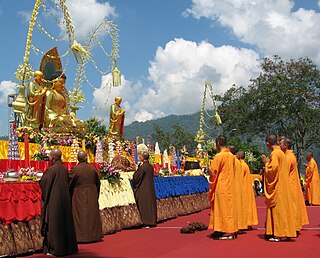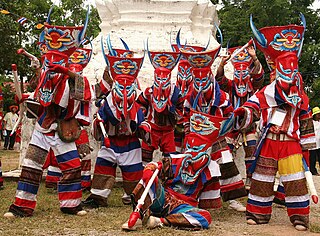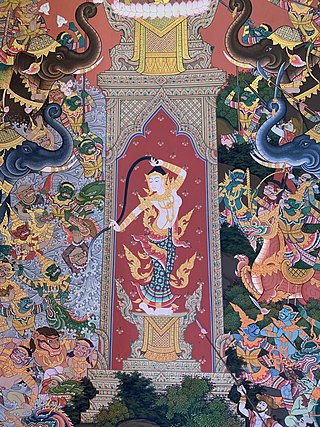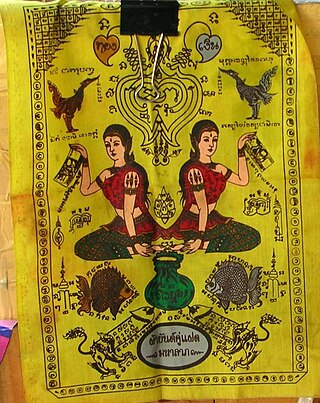Related Research Articles

Vesak, also known as Buddha Jayanti, Buddha Purnima, Buddha Day, and Phật Đản, is a holiday traditionally observed by Buddhists in South Asia and Southeast Asia, as well as Tibet and Mongolia. It is the most important Buddhist festival. The festival commemorates the birth, enlightenment (Nibbāna), and passing (Parinirvāna) of Gautama Buddha in Theravada, Tibetan Buddhism and Navayana.

The Lao people are a Tai ethnic group native to Southeast Asia, who speak the Lao language of the Kra–Dai languages. They are the majority ethnic group of Laos, making up 53.2% of the total population. The majority of Lao people adhere to Theravada Buddhism. They are closely related to other Tai people, especially with the Isan people, who are also speakers of Lao language, native to neighboring Thailand.

The Jātaka are a voluminous body of literature native to India which mainly concern the previous births of Gautama Buddha in both human and animal form. Jataka stories, were depicted on the railings and torans of the stupas. According to Peter Skilling, this genre is "one of the oldest classes of Buddhist literature." Some of these works are also considered great works of literature in their own right.

Thai literature is the literature of the Thai people, almost exclusively written in the Thai language. Most of imaginative literary works in Thai, before the 19th century, were composed in poetry. Prose was reserved for historical records, chronicles, and legal documents. Consequently, the poetical forms in the Thai language are both numerous and highly developed. The corpus of Thailand's pre-modern poetic works is large. Thus, although many literary works were lost with the sack of Ayutthaya in 1767, Thailand still possesses a large number of epic poems or long poetic tales —some with original stories and some with stories drawn from foreign sources. There is thus a sharp contrast between the Thai literary tradition and that of other East Asian literary traditions, such as Chinese and Japanese, where long poetic tales are rare and epic poems are almost non-existent. The Thai classical literature exerted a considerable influence on the literature of neighboring countries in mainland Southeast Asia, especially Cambodia and Burma.

The Rocket Festival is a merit-making ceremony traditionally practiced by ethnic Lao people at the beginning of the wet season in various villages and municipalities in Northeastern Thailand and Laos. The festivities typically include music and dance performances, competitive processions of floats, dancers and musicians on the second day, and culminating on the third day with the competitive firing of homemade rockets. Local participants and sponsors take advantage of the occasion to enhance their social prestige, as is customary in traditional Buddhist folk festivals throughout Southeast Asia.

Phi Ta Khon is a festival held in Dan Sai, Loei province, Isan, Thailand. The events take place over three days sometime between March and July, the dates being selected annually by the town’s mediums.

Laos developed its culture and customs as the inland crossroads of trade and migration in Southeast Asia over millennia. As of 2012 Laos has a population of roughly 6.4 million spread over 236,800 km2, yielding one of the lowest population densities in Asia. Yet the country of Laos has an official count of over forty-seven ethnicities divided into 149 sub-groups and 80 different languages. The Lao Loum have throughout the country's history comprised the ethnic and linguistic majority. In Southeast Asia, traditional Lao culture is considered one of the Indic cultures.

'Phra Lak Phra Ram' is the national novel of the Lao people, and is the Lao adaptation of the Dasaratha Jataka, a story narrating one of the previous life of Buddha as a Bodhisatta named Rama. It was brought to Laos and other Southeast Asia by propagation of Buddhism. The story reached Laos much later than Cambodia and Thailand (Siam) and thus was affected by local adaptation.

Merit is a concept considered fundamental to Buddhist ethics. It is a beneficial and protective force which accumulates as a result of good deeds, acts, or thoughts. Merit-making is important to Buddhist practice: merit brings good and agreeable results, determines the quality of the next life and contributes to a person's growth towards enlightenment. In addition, merit is also shared with a deceased loved one, in order to help the deceased in their new existence. Despite modernization, merit-making remains essential in traditional Buddhist countries and has had a significant impact on the rural economies in these countries.

The Ananda Temple, located in Bagan, Myanmar is a Buddhist temple built in 1105 AD during the reign (1084–1112/13) of King Kyansittha of the Pagan Dynasty. The temple layout is cruciform with several terraces leading to a small pagoda at the top covered by an umbrella known as hti, which is the name of the umbrella or top ornament found in almost all pagodas in Myanmar. The Buddhist temple houses four standing Buddha statues, each one facing the cardinal direction of East, North, West and South. The temple is said to be an architectural wonder in a fusion of Mon and adopted Indian style of architecture. The impressive temple has also been titled the "Westminster Abbey of Burma". The temple has close similarity to the Pathothamya temple of the 10th–11th century, and is also known as “veritable museum of stones”.

Thai temple art and architecture is the art and architecture of Buddhist temples in Thailand. Temples are known as wats, from the Pāḷi vāṭa, meaning "enclosure". A temple has an enclosing wall that divides it from the secular world.

Wat Phra That Phanom is a Buddhist temple in the That Phanom District in the south of Nakhon Phanom Province, all within the Isan region of Thailand near the Lao border. According to local legend, the temple contains in the pagoda the Phra Uranghathat (พระอุรังคธาตุ)/Phra Ura (พระอุระ)/Buddha's breast bones. As such, it is one of the most important structures for Theravada Buddhists and the most important Buddhist site in the province, with an annual week-long festival being held in the town of That Phanom to honour the temple. These festival attract thousands of people who make pilgrimages to the shrine. In Thai folk Buddhism, Wat Phra That Phanom is a popular pilgrimage destination for those born in the year of the Monkey.

Māgha Pūjā is a Buddhist festival celebrated on the full moon day of the third lunar month in Cambodia, Laos, Thailand, Sri Lanka and on the full moon day of Tabaung in Myanmar. It is the second most important Buddhist festival after Vesak; it celebrates a gathering that was held between the Buddha and 1,250 of his first disciples, which, according to tradition, preceded the custom of periodic recitation of discipline by monks. On the day, Buddhists celebrate the creation of an ideal and exemplary community, which is why it is sometimes called Saṅgha Day, the Saṅgha referring to the Buddhist community, and for some Buddhist schools this is specifically the monastic community. In Thailand, the Pāli term Māgha-pūraṇamī is also used for the celebration, meaning 'to honor on the full moon of the third lunar month'. Finally, some authors referred to the day as the Buddhist All Saints Day.

The Vessantara Jātaka is one of the most popular jātakas of Theravada Buddhism. The Vessantara Jātaka tells the story of one of Gautama Buddha's past lives, about a very compassionate and generous prince, Vessantara, who gives away everything he owns, including his children, thereby displaying the virtue of perfect generosity. It is also known as the Great Birth Sermon.

Vasundharā or Dharaṇī is a chthonic goddess from Buddhist mythology of Theravada in Southeast Asia. Similar earth deities include Pṛthivī, Kṣiti, and Dharaṇī, Vasudhara bodhisattva in Vajrayana and Bhoomi devi and Prithvi in hinduism.

Thai folklore is a diverse set of mythology and traditional beliefs held by the Thai people. Most Thai folklore has a regional background for it originated in rural Thailand. With the passing of time, and through the influence of the media, large parts of Thai folklore have become interwoven with the wider popular Thai culture.
The people of Laos have a rich literary tradition dating back at least six hundred years, with the oral and storytelling traditions of its peoples dating back much earlier. Lao literature refers to the written productions of Laotian peoples, its émigrés, and to Lao-language works. In Laos today there are over forty-seven recognized ethnic groups, with the Lao Loum comprising the majority group. Lao is officially recognized as the national language, but owing to the ethnic diversity of the country the literature of Laos can generally be grouped according to four ethnolinguistic families: Lao-Tai (Tai-Kadai); Mon-Khmer (Austroasiatic); Hmong-Mien (Miao-Yao), and Sino-Tibetan. As an inland crossroads of Southeast Asia the political history of Laos has been complicated by frequent warfare and colonial conquests by European and regional rivals.

Sang Sinxay is a Lao epic poem written by Pang Kham. It tells the story of the hero Sinxay (ສິນໄຊ) who goes on a quest to rescue his aunt Soumountha (ສູມຸນທາ) who was abducted by the demon Nyak Koumphan (ຍັກກູມພັນ). The poem is believed to have been written sometime between the mid-16th and the end of the 17th century in the Lao kingdom of Lan Xang. Sang Sinxay is considered one of the three masterpieces of Lao literature. The poem is popular in Laos and in the Isan region of Thailand, where its scenes are also depicted on numerous temples.
Sādhu or Sathu is a Pali word of Sanskrit origin which is used as a formula of approbation in both religious and secular contexts in Southeast Asia. It is a kind of Buddhist Amen, similar also to the Svāhā used as a denouement at the end of a mantra in Vedic religions which also served as a form of salutation. Though it is an "untranslatable phrase", it can be variously translated as "amen", "good", "yes" "thank you", "I have received", "well done", "be it so" or "all shall be well".
References
- ↑ Phya Khankhaak, the Toad King: A Translation of an Isan Fertility Myth in Verse. Bucknell University Press. 1996. p. 152. ISBN 978-0-8387-5306-4.
- ↑ Kislenko, Arne (2009). Culture and Customs of Laos. ABC-CLIO. p. 146. ISBN 978-0-313-33977-6.
- ↑ Reynolds, University Frank E.; Reynolds, Frank; Carbine, Jason A.; Carbine, Jason (2000). The Life of Buddhism. University of California Press. p. 64. ISBN 978-0-520-21105-6.
- ↑ Collins, Steven (2016-03-29). Readings of the Vessantara Jātaka. Columbia University Press. ISBN 978-0-231-54100-8.
- ↑ Miller, Terry; Williams, Sean (2011-03-17). The Garland Handbook of Southeast Asian Music. Routledge. p. 140. ISBN 978-1-135-90155-4.
- ↑ Tiyavanich, Kamala (2018-09-04). In the Cool Shade of Compassion: The Enchanted World of the Buddha in the Jungle. Shambhala Publications. p. 25. ISBN 978-1-61180-649-6.
- ↑ Rajadhon 2009.
- ↑ Brown, Rebecca M.; Hutton, Deborah S. (2015-06-22). A Companion to Asian Art and Architecture. John Wiley & Sons. p. 58. ISBN 978-1-119-01953-4.
- ↑ Chambers 1992.
- ↑ Green, Gill; Green (Curator), Gillian (2008). Pictorial Cambodian Textiles. River Books. p. 82. ISBN 978-974-9863-39-8.
- ↑ ទៀវ, វិចិត្រ (2021). "ពិធីបុណ្យទេសន៍មហាជាតក". Yosothor Khmer Renaissance Dictionnary (in Khmer). Retrieved January 19, 2022.
- ↑ Green, Alexandra (2013-01-01). Rethinking Visual Narratives from Asia: Intercultural and Comparative Perspectives. Hong Kong University Press. p. 229. ISBN 978-988-8139-10-1.
- ↑ Obeyesekere 2009, pp. 17, 19, 22.
- ↑ "มหาเวสสันดรชาดก (Maha Wetsandon Chadok)". SEAsite. Northern Illinois University. Archived from the original on 17 February 2012.
- ↑ Brereton, Bonnie Pacala (1995). Thai Tellings of Phra Malai: Texts and Rituals Concerning a Popular Buddhist Saint. Arizona State University, Program for Southeast Asian Studies. p. 61. ISBN 978-1-881044-07-9.
- ↑ Phi Ta Khon Festival - Thailand Tourism Archived 2008-07-04 at the Wayback Machine
- ↑ Campbell, Chris; Niblett, Michael; Oloff, Kerstin (2021-08-12). Literary and Cultural Production, World-Ecology, and the Global Food System. Springer Nature. p. 129. ISBN 978-3-030-76155-4.